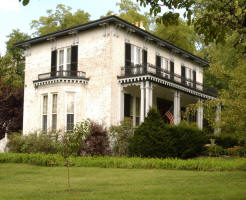Edgewood (Sunnyside)
The Walter N. Haldeman Years (1854-1864)
go back to Edgewood, The Little Colonel Years and Beyond
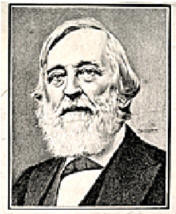 While the Craig family made Edgewood famous worldwide, its previous owner, newspaper publisher Walter Newman Haldeman, made it somewhat notorious during the Civil War.
While the Craig family made Edgewood famous worldwide, its previous owner, newspaper publisher Walter Newman Haldeman, made it somewhat notorious during the Civil War.
Haldeman purchased the country estate from Henry Smith in 1854. A May 1987 thesis submitted to the faculty of the graduate school of the University of Louisville titled “Gentleman of the Press: The Life and Times of Walter Newman Haldeman” by Dennis Charles Cusick, pages 22-24, talks about the reason for his move to the country:
…His wife was obsessed with ailments that appear from her letters to have been largely psychosomatic – dizziness, fainting, lack of energy, and recurrent menstrual discomfort. In her attempt to relieve this suffering, she left her husband and eight-year-old son Willie for months at a time while she stayed at the Cincinnati Water Cure (Note that Cincinnati was her home town) and later the Cleveland Water Cure. Her letters to Louisville were gloomy recitations of her maladies, such as this from February 18, 1954: ‘I sometimes think if it is to always be with me as it is now, that if it would please God to take me I would rather go than drag out a life of misery – but I do hope for better days. When my head is once clear I shall feel like a different being.’
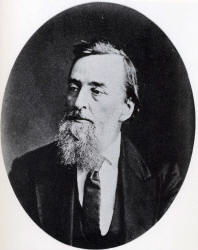 Mrs. Haldeman remained at the Cleveland Water Cure from February to September 1854. Her husband, in an attempt to placate her fear of the unhealthiness of the city of Louisville, bought property in the Rollington subdivision of Oldham County while she was gone. The subdivision, which became Pewee Valley, had just become accessible to Louisville through the completion of the Louisville & Frankfort Railroad in 1851. For less than four thousand dollars, Haldeman acquired a brick home with a tin roof on more than fifty acres and a blackberry patch where a boy, such as his own son, would ‘almost hurt himself eating the delicious berries.’
Mrs. Haldeman remained at the Cleveland Water Cure from February to September 1854. Her husband, in an attempt to placate her fear of the unhealthiness of the city of Louisville, bought property in the Rollington subdivision of Oldham County while she was gone. The subdivision, which became Pewee Valley, had just become accessible to Louisville through the completion of the Louisville & Frankfort Railroad in 1851. For less than four thousand dollars, Haldeman acquired a brick home with a tin roof on more than fifty acres and a blackberry patch where a boy, such as his own son, would ‘almost hurt himself eating the delicious berries.’
…By the fall of 1854, the Haldeman family was reunited in the new home in Pewee Valley, appointed with new furniture that Haldeman had purchased while his wife was away. A mortgage filed the following year shows that this country home contained:
2 horses, 2 plows, 1 harrow, 6 hoes and rakes, 6 shovels and spades, 2 scythes, 1 garden roller, 1 cart, 1 Rockaway and harness, 2 cows, 1 Book case and 350 volumes of Books, 3 bedsteads and bedding, 1 Cupboard, 2 wardrobes, 2 beaureaux, 1 piano, 1 what not, 2 dozzen (sic) chairs, 1 cuch, 1 Gold watch, 1 extension table, 3 small tables, 2 wash stands, 4 carpets, 1 rug, 2 stoves…knives & forks, tea sets, shovels, tongs, cooking utensils etc., also 2 clocks, 2 saddles, and one old negro woman named Elva.
Though Elizabeth Metcalfe Haldeman’s maladies may have been psychosomatic, as a Cincinnati native, she was doubtless well aware of Louisville’s reputation as “the graveyard of the West.” Heavily polluted ground water led to rampant outbreaks of cholera and typhoid until the Louisville Water Company was chartered in 1854. In an effort to persuade his wife to leave the Cleveland Water Cure, Haldeman named his new country estate Sunnyside to underscore Pewee Valley’s healthful climate.
It’s possible that Haldeman learned about the property’s availability through his association with W. D. Gallagher, who had been living on a farm not far from Sunnyside-Edgewood since 1850. According to “Gentleman of the Press: The Life and Times of Walter Newman Haldeman,” page 21, Haldeman, who owned the “Courier” newspaper at time, partnered with the poet the year prior to purchasing his country estate:
…Haldeman did take in an overtly anti-slavery partner in 1853, poet William D. Gallagher, but their views became increasingly at odds as Haldeman moved toward a pro-slavery position. Haldeman bought Gallagher out in June 1854…
Haldman’s pro-slavery stance eventually led to confiscation of his home by Union forces during the War Between the States, according to “Historic Pewee Valley,” page 7:
…In 1863 a band of guerillas descended on Pewee Valley, seized a locomotive and sent it minus its engineer racing down the track toward Louisville. The only other war-related event of note was the confiscation by Federal troops of W. N. Haldeman’s home, Sunnyside-Edgewood, because of his outspoken support for the South, voiced by him in his newspaper The Louisville Morning Courier. This type of treatment of Southern sympathizers occurred throughout Kentucky during the war, since Federal troops occupied most of the state….
A much more detailed and thrilling account of the confiscation – including the role of other Pewees in trying to avert it – is included in “Gentleman of the Press: The Life and Times of Walter Newman Haldeman,” pages 50-54:
The Civil War confronted Haldeman on his way to work on the morning of September 19, 1861, though he had tried to avoid it for as long as he could. He had found himself in an ever more precarious position over the course of the summer; his readers were fleeing to the South, and Louisville was becoming more and more a Union stronghold. Still, he tried to hold on, having just invested eight thousand dollars in new equipment for the “Courier,” which he estimated to be worth more than fifty thousand dollars. It was an investment he was not inclined to abandon.
Kentucky’s official position of neutrality had suited his purposes in the early months of the war, though editorially the “Courier” had opposed it. Neutrality protected the “Courier” for a time, allowing it to advocate the Southern cause, cheer the success of the Confederate army, and denounce the administration of “King Lincoln” in a state that remained in the union. Such a position would have been untenable in the Northern states, where newspapers were getting into trouble for much less overt criticism of the government.
Indeed, the “Courier’s” position quickly became impossible in Louisville. Within hours of the state legislature’s vote to end neutrality and take up the Union cause, the United States Post Office Department banned the “Courier” from the mails as ‘an advocate of treason’ and the United States marshal in Louisville seized the “Courier’s” office and arrested former editor Durrett on a charge of treason. Haldeman was able to avoid arrest only because his residence was in relatively remote Pewee Valley, sixteen miles east of Louisville. But the fate of the “Courier” had been taken out of his hands.
Haldeman learned about the suppression of the “Courier” before he left home the next morning; he was warned that deputies intended to arrest him. Nevertheless, he went to the Pewee Valley station and boarded the morning train to Louisville with two of his neighbors, Noble Butler and William H. Walker, with whom Haldeman discussed the situation and what he hoped to do about it. He told them he wanted to get word to General Robert Anderson, the Union commander in Kentucky, requesting permission to reopen the “Courier” ‘as a mere newspaper,…abstaining entirely from political discussions, and that if the publication of any particular item of news should be regarded as injurious to the Government, it might be suppressed by the person or persons under whose supervision the paper might be placed.’ Butler and Walker offered to visit Anderson in his room at the Louisville Hotel and present Haldeman’s proposal for resuming publication. Upon their advice that Haldeman would risk arrest if he continued on the train to Louisville, he got off at the next stop, and agreed to await word of their negotiations at O’Bannon’s Station.
Some of those who interceded on his behalf – and the list grew to more than a half-dozen – later claimed to have been betrayed by Haldeman. Dr. T. S. Sell, who accompanied Butler and Walker to the meeting with Anderson, wrote that everyone except Haldeman had acted in good faith, while he was merely stalling for time to make his escape to the South. None would have gotten involved, Bell said, if they had known Haldeman’s real plans.
Haldeman later acknowledged that he never intended to remain after the “Courier” had been suppressed. He did want to keep the newspaper operating for the sake of the continued employment of its fifteen to twenty longtime employees, but he hoped that this could be done under the management of others. ‘I certainly did carry on my negotiations with G E. Anderson for this purpose,’ Haldeman wrote a month later, ‘and the object sought to be attained, would, I think, have justified me, or at least have made it pardonable.’
Butler wrote to Haldeman after the first meeting with Anderson that the general ‘will consent to your publishing the “Courier” on condition that you will write an article pledging yourself that you will be loyal to Kentucky and to the Union as long as Kentucky is a member of the Union, expressing your regret at the past action of the paper, and that he shall see the article before it is printed.’
Bell also wrote to Haldeman; he related Anderson’s demand and suggested specific language of a statement by Haldeman that might be acceptable to the general. Haldeman’s reply, delivered to Bell by messenger the next evening, reiterated his proposal ‘to publish no political articles whatsoever,’ and to submit all articles to military censors. It did not apologize for the past conduct of the paper, though it did pledge loyalty to the state and Union.
Haldeman’s statement, with a slight change in its introduction, was published in the “Louisville Journal” the following day, September 21. On that morning’s train, Bell sent a letter to Haldeman’s residence by messenger, J. H. Stackhouse, to inform him that Anderson had accepted his statement. Stackhouse also carried another letter, from the United States marshal, saying that Haldeman would not be arrested and could open his office again. The letters were not delivered; Haldeman had already fled South.
Haldeman had anticipated the “Courier’s” suppression months before it happened, and had concluded that he would go south to ‘a locality where I could still breathe and think as a freeman.’ In July, he tried to protect his financial interests by transferring the title to his home to his wife’s name. When the moment to flee arrived, Haldeman headed for Bowling Green, Kentucky, then under the control of Confederate General Simon Bolivar Buckner. Haldeman’s wife and three children stayed behind at Pewee Valley. They would join him in December, after securing a travel pass from Union General Don Carlos Buell….
“Historic Pewee Valley,” page 66, provides this version of what occurred when Federal troops rode up the drive intent on confiscating Sunnyside:
One of Haldeman’s loyal, unarmed servants tried to dissuade them from their mission with the following comment, “If you want to go in there, okay, but everybody in the house is sick with Scarlet Fever. I just though you should know.”
The Haldeman family returned to Louisville after the war, but never again lived in Pewee Valley. Walter rebuilt his fortune; merged the “Courier” with the “Louisville Journal” to create the “Courier-Journal,” which remains to this day Louisville’s only daily newspaper; and founded the now-defunct afternoon “Louisville Times.” He died on May 13, 1902, victim of a streetcar accident, leaving his newspaper empire to his three children, Bruce, Will and Isabelle. On August 6, 1918, his descendents sold the business to Robert Worth Bingham.
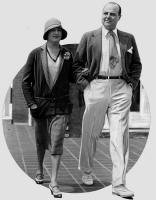 [Photo left: Craig and Bess Haldeman Culbertson 1930s]
[Photo left: Craig and Bess Haldeman Culbertson 1930s]
Besides his ownership of Sunnyside-Edgewood, did Walter Haldeman have any “Little Colonel” connections? Annie Fellow Johnston mentions the “Courier-Journal” several times throughout the series, but none of the Haldeman family ever served as models for characters in her books. However, there were two real-life connections.
First, according to Gentleman of the Press,” in 1840 Walter Haldeman “took a clerk’s job that would set the course for the rest of his professional life – working for George W. Weissinger (the model for Annie Fellows Johnston’s Old Colonel) in the counting room of the ‘Louisville Journal,’ the most influential Whig newspaper in the West. Haldeman learned the fundamentals of newspaper accounting methods, printing and journalism in his three years at the ‘Journal.’”
The second connection, though much later than the Little Colonel Stories, was through the marriage of one of Haldeman’s grandchildren, Bessie Haldeman (the second of three daughters of Haldeman’s son John) to former Little Knight of Kentucky, Keith McIntyre (Craig Culbertson).
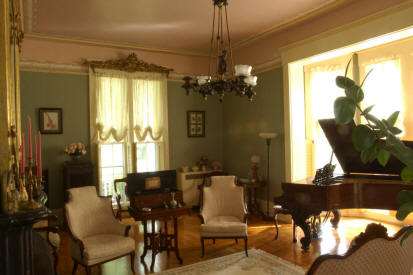
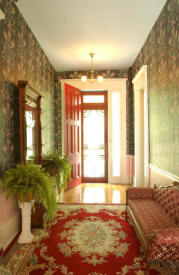
Inside Edgewood today
Edgewood Manor in its present location. Photos by John Nation of Louisville Magazine
Page by Donna Russell, owner of Edgewood
